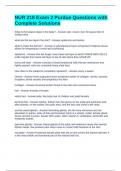NUR 218 Exam 2 Purdue Questions with
Complete Solutions
What is the largest organ in the body? - Answer-skin, covers over 20 square feet of
surface area
what are the two layers the skin? - Answer-epidermis and dermis
what is under the dermis? - Answer-a subcutaneous layer composed of adipose tissue,
allows for temperature control and cushioning
epidermis - Answer-thin but tough, inner basal cell layer is what FORMS NEW CELLS
(cells migrate from basal cell layer to top of skin where they schleff off)
horny cell layer - Answer-consists of dead keratinized cells that are interwoven and
tightly packed, cells are constantly being shed here
How often is the epidermis completely replaced? - Answer-every 4 weeks
Dermis - Answer-inner supportive layer composed mainly of collagen, nerves, sensory
receptors, blood vessels and lymphatics live here
Collagen - Answer-structural protein found in the skin and connective tissue
hair - Answer-threads of keratin
vellus hair - Answer-pale, fine body hair of children and adult females
terminal hair - Answer-Darker, thicker hair that grows on the scalp and eyebrows and,
after puberty, on the axillae, the pubic area, and the face and chest in the male.
eccrine sweat glands - Answer-Secreting glands, are far more numerous and are
abundant on palms, soles of feet and forehead. Each is a simple, coiled, tubular gland.
Ducts connect to pores. Sweat: 99% water, NaCl, vitamin C, antibodies, dermcidin and
metabolic wastes.
apocrine glands - Answer-Sweat glands in the pubic and underarm areas that secrete
thicker sweat, that produce odor when come in contact with bacteria on the skin
nail plate - Answer-Hardened keratin plate that sits on and covers the natural nail bed. It
is the most visible and functional part of the natural nail unit.
, Function of skin - Answer-protection, prevents penetration, perception, temperature
regulation, identification, communication, wound repair, absorption and excretion,
production of vitamin D
when do babies develop hair follicles - Answer-3 months of gestation
Lanugo - Answer-fine, soft hair, especially that which covers the body and limbs of a
human fetus or newborn.
why do newborns have a greater risk of fluid loss? - Answer-their skin is more
permeable due to thinner hair and the smoothness and elasticity of the hair
what occurs in the skin during pregnancy? - Answer-metabolism is increased, peripheral
vasculature dilates and the sweat and sebaceous glands increase secretions
what occurs in the skin in aging adults? - Answer-atrophy of skin structures, skin loses
its elasticity, folds, sags, becomes dry, wrinkles
what causes the increase in risk for skin tearing in aging adults? - Answer-loss of
collagen
why are older adults at a greater risk for heat stroke? - Answer-decreased response of
sweat glands due to thermoregulation
senile purpura - Answer-discoloration due to increasing capillary fragility, ex. bruising
exstensively due to minor trauma
why does skin and hair develop a gray or white look in old age? - Answer-decrease in
the number of functioning melanocytes
what kind of objective information does the skin hold? - Answer-information about body
circulation, nutritional status, signs of systemic diseases, topical data on the integument
itself
what does intertriginous areas mean? - Answer-areas with skin folds
hypopigmentation - Answer-areas of skin lacking color because of deficient amounts of
melanin
hyperpigmentation - Answer-darkened areas of skin caused by excessive amounts of
melanin
senile lentigines - Answer-liver spots, brown macules commonly found on the backs of
hands, forearms and face




